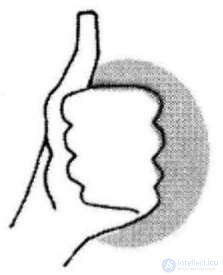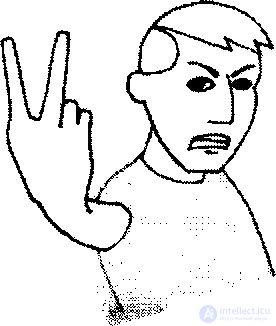Let's analyze the national interpretations and applications of the three most common gestures - the ring, the thumb raised upwards and the V sign.
1. RING This gesture became widespread in the USA at the beginning of the 19th century, when abbreviations of the most frequently used phrases were used in newspapers. There are many opinions about what the letters OK mean. Some people think that it means “All is right”. In English, this expression is often spelled incorrectly - instead of “all correct” they write “oll korrect”. Others (read this abbreviation as the antonym for the word knock-out (KO)).

This gesture for the people of Western countries means "ok",
for the Japanese - money, for the French - zero,
but for the Turks and Brazilians - is a deadly insult Another popular version is that “OK” is the abbreviation “Old Kinderhook” (“Old Kinderhook”). In this town was born one of the presidents of the United States in the XIX century. He used this abbreviation as his campaign slogan. Obviously, the ring clearly designates the letter “O” in the OK signal. The meaning of “okay” is universal for all English-speaking countries. It has rapidly spread throughout the world thanks to American films and television. However, such a gesture in different countries may have a completely different meaning. In France and Belgium, it means "zero" or "nothing." Once in Paris a waiter asked us if we were satisfied with the table. I made the "ok" gesture, and he immediately began to apologize: "If you don't like the table, I can offer you another one." He interpreted my gesture as a “zero” - in other words, I thought that we were unhappy with the place.
|
If a Frenchman asks what you think about French cuisine, and you make an “ok” gesture, he will be mortally offended.
| |
In Japan, such a gesture means "money." If you do business with the Japanese and make a similar gesture during the negotiations, the Japanese will decide that you offer him a bribe. In some Mediterranean countries, this gesture is considered an offensive hint at a man’s homosexuality. Make a similar gesture in the presence of a Greek, and he will think that you call him or yourself gay. The Turk will decide that you insult him by calling him “ass.” Such a gesture is rarely used in Arab countries, since it is regarded there either as a signal of threat or as obscenity.
In the 1950s, Richard Nixon visited the countries of Latin America with a visit of goodwill to ease tensions between countries. Coming off the plane, he greeted the people waiting for him with the American “Okay” gesture. Perturbed noise and whistling extremely surprised Nixon. Being unfamiliar with the local language of body movements, Nixon welcomed the people who met him with a statement: “All of you are asses!”
2. BIG FINGER, RAISED UP In countries with strong UK influence, such as Australia, USA, South Africa, Singapore or New Zealand, the raised thumb has three meanings. First, those who hitchhike stop cars. Secondly, it is a signal that everything is in order. If the gesture is done very vigorously and abruptly, it is interpreted as an insult of a sexual nature. In some countries, for example, in Greece, the thumb is thrust forward, which means “Fuck you!”.
|
Never hitchhike in Greece.
| |
As we have said, counting from one to five, Europeans start with a thumb. Most of those who speak English, start counting with the index finger, and the big they mean "five."

Such a gesture can mean “excellent,” “one,” “you went,” or “five,” depending on where you see it. Since the thumb is traditionally used as a symbol of authority and authority, people often put it out of their pockets or vests. Exposed thumb in combination with other gestures is regarded as a sign of superiority and strength.
3. SIGN V This gesture is common in Australia, New Zealand and the UK. It carries a negative connotation and can be interpreted as “may you go”. During the Second World War, Winston Churchill used it as a symbol of victory (V - Victory), but he opened his hand to his interlocutor, while in an offensive gesture his palm was turned from his interlocutor.
Such a gesture is rooted in the deep past. The English archers used the middle and index fingers to guide their arrows. Archers who were captured were often cut off so that they could no longer shoot. The V sign was used as an insulting battle sign. So the English archers showed the enemy that they still have something to shoot.

For an American, such a gesture means “two,” for a German, “victory,” for an Englishman, “may you go” On the mainland, the gesture of V with a palm towards itself began to mean victory. The British boldly insulted the defeated Germans with a familiar gesture, and they believed that the winners emphasize their victory. In some countries of Europe, this gesture means a two. The English, who brazenly insulted the owner of the tavern, could bring two mugs of beer.



Comments
To leave a comment
Body language
Terms: Body language